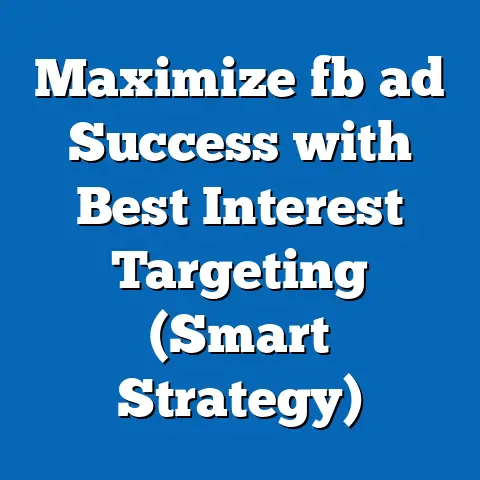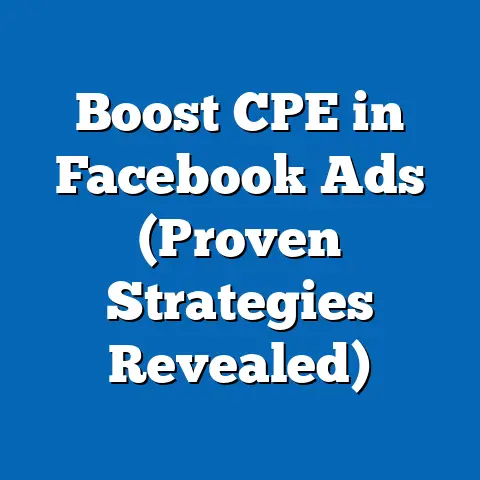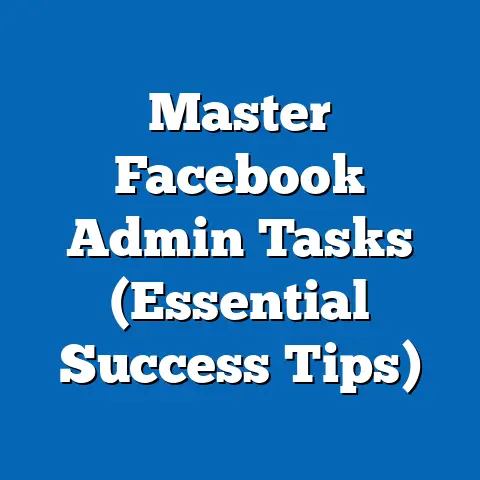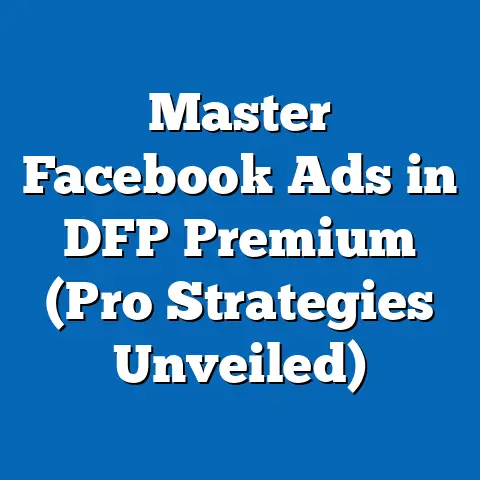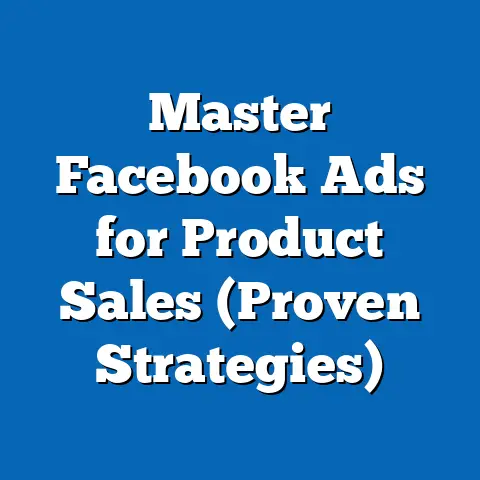Revert Facebook Ads Changes (Power Strategies for Success)
Ever feel like planning a picnic only to have a sudden downpour ruin everything? That’s kind of what navigating Facebook Ads can feel like sometimes. One minute you’re basking in the sunshine of a successful campaign, the next, a sudden algorithm update or platform change throws a wrench in your plans. Just like those unpredictable weather patterns, the world of Facebook Ads is constantly evolving, demanding that we, as advertisers, become masters of adaptation. But what happens when the “new normal” isn’t working? That’s when knowing how to strategically revert to proven strategies becomes your superpower.
In this guide, I’m going to walk you through the ins and outs of reverting changes in your Facebook Ads, sharing my own experiences, insights, and actionable strategies that will help you not only weather the storm but come out stronger on the other side.
Understanding Recent Changes in Facebook Ads
Let’s face it, Facebook (or Meta, as it’s now known) loves to keep us on our toes. Over the past year, leading up to October 2024, we’ve seen a whirlwind of updates, from shifts in algorithm priorities to changes in targeting options and even new ad formats popping up. These changes, while often intended to improve user experience and ad relevance, can sometimes feel like a curveball to our carefully crafted campaigns.
One of the biggest shifts I’ve personally noticed is the increasing emphasis on privacy. With growing concerns about data usage, Facebook has been tightening its grip on tracking, making it harder to target specific demographics and interests. This has forced many advertisers to rethink their entire targeting strategy, shifting from hyper-specific audiences to broader, more interest-based targeting.
Another significant change has been the rise of AI and machine learning in ad delivery. While this can be a good thing, automating ad optimization can also lead to unexpected results if not carefully monitored. I’ve seen campaigns that were initially performing well suddenly tank after Facebook’s AI took over, highlighting the importance of staying vigilant and understanding how these automated systems work.
According to a recent report by Statista, advertising revenue on Facebook has experienced some volatility in the past year due to these platform changes and global economic factors. This underscores the need for advertisers to be agile and prepared to adapt their strategies on the fly.
Key Takeaway: Facebook Ads is a constantly evolving landscape. Staying informed about recent changes is crucial for understanding how they impact your campaigns and knowing when to revert to proven strategies.
The Importance of Reverting to Proven Strategies
In the face of constant change, it’s tempting to jump headfirst into the latest trends and features, hoping to stay ahead of the curve. However, I’ve learned through experience that sometimes the best approach is to take a step back and revisit what has worked in the past.
Think of it like this: you’ve spent months perfecting a recipe that consistently delivers delicious results. Then, a new ingredient comes along, promising to make your dish even better. Would you blindly swap out all your existing ingredients for this new one without first testing its impact? Probably not.
The same principle applies to Facebook Ads. Reverting to proven strategies is not about being resistant to change; it’s about making informed decisions based on data and experience. It’s about mitigating risk and ensuring that your advertising efforts continue to deliver results, even in the face of uncertainty.
I remember working with a client in the e-commerce space who was eager to embrace all the latest Facebook ad features. They completely revamped their entire campaign structure, abandoning their tried-and-true targeting and creative strategies. The result? A significant drop in conversion rates and a massive increase in cost per acquisition.
After analyzing the data, we decided to revert to their previous strategy, focusing on their core audience and proven ad creatives. Within a few weeks, their performance rebounded, and they were back on track to achieving their sales goals.
Key Takeaway: Reverting to proven strategies is not about being stuck in the past. It’s about making data-driven decisions and mitigating risk in a constantly changing environment.
Power Strategies to Revert Facebook Ads Changes
Now, let’s get down to the nitty-gritty. Here are some power strategies you can use to effectively revert changes in your Facebook Ads and get your campaigns back on track:
1. Analyze Historical Data
This is your foundation. Before making any decisions about reverting changes, you need to dive deep into your historical ad performance data. What campaigns were successful in the past? Which targeting options delivered the best results? What ad creatives resonated most with your audience?
- Actionable Steps:
- Use Facebook Ads Manager: Navigate to the “Reports” section in Facebook Ads Manager and generate custom reports that focus on key metrics like reach, impressions, click-through rate (CTR), conversion rate, and cost per acquisition (CPA).
- Segment Data: Segment your data by campaign, ad set, ad, audience, and placement to identify specific areas of success and areas for improvement.
- Identify Patterns: Look for patterns and trends in your data. For example, you might discover that a specific audience segment consistently delivers a higher conversion rate or that a particular ad creative format consistently outperforms others.
- Document Findings: Create a document or spreadsheet to summarize your findings and identify key takeaways. This will serve as your guide when reverting changes and optimizing your campaigns.
- Use Facebook Ads Manager: Navigate to the “Reports” section in Facebook Ads Manager and generate custom reports that focus on key metrics like reach, impressions, click-through rate (CTR), conversion rate, and cost per acquisition (CPA).
- Segment Data: Segment your data by campaign, ad set, ad, audience, and placement to identify specific areas of success and areas for improvement.
- Identify Patterns: Look for patterns and trends in your data. For example, you might discover that a specific audience segment consistently delivers a higher conversion rate or that a particular ad creative format consistently outperforms others.
- Document Findings: Create a document or spreadsheet to summarize your findings and identify key takeaways. This will serve as your guide when reverting changes and optimizing your campaigns.
Personal Experience: I once had a campaign that was performing exceptionally well, but then I decided to “optimize” it by changing the ad creative. Big mistake! The performance tanked almost immediately. By analyzing my historical data, I realized that the original ad creative was the key to success. I reverted back to it, and the campaign quickly recovered.
2. Audience Retargeting
Retargeting is a powerful strategy for reconnecting with people who have already shown interest in your brand or products. By targeting users who have visited your website, engaged with your content, or made previous purchases, you can significantly increase your chances of driving conversions.
- Actionable Steps:
- Create Custom Audiences: Use Facebook’s custom audience feature to create audiences based on website traffic, customer lists, app activity, and engagement on Facebook and Instagram.
- Segment Audiences: Segment your custom audiences based on their level of engagement. For example, you might create a separate audience for people who abandoned their shopping cart versus those who simply visited your website.
- Tailor Messaging: Tailor your ad messaging to resonate with each audience segment. For example, you might offer a discount to people who abandoned their shopping cart or showcase relevant products to people who visited specific pages on your website.
- Exclude Existing Customers: Exclude existing customers from your retargeting campaigns to avoid wasting ad spend on people who have already made a purchase.
- Create Custom Audiences: Use Facebook’s custom audience feature to create audiences based on website traffic, customer lists, app activity, and engagement on Facebook and Instagram.
- Segment Audiences: Segment your custom audiences based on their level of engagement. For example, you might create a separate audience for people who abandoned their shopping cart versus those who simply visited your website.
- Tailor Messaging: Tailor your ad messaging to resonate with each audience segment. For example, you might offer a discount to people who abandoned their shopping cart or showcase relevant products to people who visited specific pages on your website.
- Exclude Existing Customers: Exclude existing customers from your retargeting campaigns to avoid wasting ad spend on people who have already made a purchase.
Personal Experience: I’ve found that retargeting website visitors with abandoned shopping carts is one of the most effective retargeting strategies. By offering a small discount or free shipping, you can often entice them to complete their purchase.
3. Ad Creative Optimization
Your ad creative is the first thing people see, so it needs to be compelling and relevant to your target audience. Reverting to successful ad creatives can be a great way to boost performance, especially if you’ve recently experimented with new formats or messaging that didn’t resonate.
- Actionable Steps:
- A/B Test Previous Ad Formats: Revisit your previously successful ad formats and messages. Use A/B testing to identify winning combinations.
- Focus on High-Performing Elements: Identify the elements of your ad creative that resonated most with your audience, such as specific images, headlines, or calls to action.
- Replicate Success: Replicate these elements in your new ad creatives while also experimenting with minor variations to keep things fresh.
- Use High-Quality Visuals: Ensure that your ad visuals are high-quality, visually appealing, and relevant to your target audience.
- A/B Test Previous Ad Formats: Revisit your previously successful ad formats and messages. Use A/B testing to identify winning combinations.
- Focus on High-Performing Elements: Identify the elements of your ad creative that resonated most with your audience, such as specific images, headlines, or calls to action.
- Replicate Success: Replicate these elements in your new ad creatives while also experimenting with minor variations to keep things fresh.
- Use High-Quality Visuals: Ensure that your ad visuals are high-quality, visually appealing, and relevant to your target audience.
Personal Experience: I once had a client who was struggling to generate leads with their Facebook Ads. After analyzing their previous campaigns, I discovered that a simple video ad featuring a customer testimonial had been incredibly successful. We decided to revive that ad, and the leads started pouring in again.
4. Budget Reallocation
Sometimes, the key to reverting changes is simply reallocating your budget to focus on the ads and campaigns that are performing best. If you’ve recently experimented with new campaigns or targeting options that aren’t delivering results, consider shifting your budget back to your proven winners.
- Actionable Steps:
- Identify Underperforming Ads: Identify the ads and campaigns that are underperforming and consuming a disproportionate amount of your budget.
- Pause or Reduce Budget: Pause or significantly reduce the budget for these underperforming ads and campaigns.
- Reallocate Funds: Reallocate the funds to your high-performing ads and campaigns, focusing on those that have historically yielded a high ROI.
- Monitor Performance: Monitor the performance of your reallocated budget closely and make adjustments as needed.
- Identify Underperforming Ads: Identify the ads and campaigns that are underperforming and consuming a disproportionate amount of your budget.
- Pause or Reduce Budget: Pause or significantly reduce the budget for these underperforming ads and campaigns.
- Reallocate Funds: Reallocate the funds to your high-performing ads and campaigns, focusing on those that have historically yielded a high ROI.
- Monitor Performance: Monitor the performance of your reallocated budget closely and make adjustments as needed.
Personal Experience: I’ve often found that reallocating budget from underperforming prospecting campaigns to high-converting retargeting campaigns can significantly improve overall ROI.
5. Leveraging Facebook Groups and Communities
Facebook Groups and Communities can be a goldmine of insights and opportunities for engagement. By actively participating in relevant groups, you can gain a deeper understanding of your target audience’s needs, interests, and pain points. This information can be invaluable when reverting changes and optimizing your ad strategies.
- Actionable Steps:
- Join Relevant Groups: Identify and join Facebook Groups that are relevant to your industry, niche, or target audience.
- Engage Authentically: Participate in discussions, answer questions, and share valuable content. Avoid simply promoting your products or services.
- Gather Insights: Pay attention to the questions people are asking, the topics they are discussing, and the challenges they are facing.
- Build Relationships: Build relationships with other members of the group, including influencers and thought leaders.
- Join Relevant Groups: Identify and join Facebook Groups that are relevant to your industry, niche, or target audience.
- Engage Authentically: Participate in discussions, answer questions, and share valuable content. Avoid simply promoting your products or services.
- Gather Insights: Pay attention to the questions people are asking, the topics they are discussing, and the challenges they are facing.
- Build Relationships: Build relationships with other members of the group, including influencers and thought leaders.
Personal Experience: I’ve used Facebook Groups to gather valuable feedback on new product ideas and ad creatives. By getting direct input from my target audience, I’ve been able to create more effective ads that resonate with their needs and interests.
Case Studies of Successful Reversion Strategies
To illustrate the power of reverting changes, let’s take a look at a couple of real-world examples:
- Case Study 1: E-commerce Brand Reverts to Proven Ad Creative
An e-commerce brand selling handmade jewelry experienced a significant drop in sales after launching a new ad campaign featuring professionally produced product photos. After analyzing their data, they realized that their previous campaign, which used user-generated content (UGC) photos, had been much more successful. They reverted to using UGC photos in their ads, and their sales quickly rebounded.
- Case Study 2: SaaS Company Reallocates Budget to Retargeting
A SaaS company struggling to generate leads with their prospecting campaigns decided to reallocate their budget to retargeting website visitors who had downloaded a free trial. By targeting these users with personalized ads showcasing the benefits of their software, they were able to significantly increase their conversion rates and generate more qualified leads.
Key Takeaway: These case studies demonstrate that reverting to proven strategies can be a highly effective way to improve ad performance and achieve your marketing goals.
Conclusion
The world of Facebook Ads is a dynamic and ever-changing landscape. While it’s important to stay up-to-date with the latest trends and features, it’s equally important to remember the power of reverting to proven strategies. By analyzing your historical data, leveraging audience retargeting, optimizing your ad creative, reallocating your budget, and engaging with Facebook Groups and Communities, you can navigate the inevitable changes and challenges that come your way and continue to drive success with your Facebook Ads.
Remember, the key is to remain adaptable and to continuously analyze your advertising efforts to find the right balance between innovation and tried-and-true methods. By doing so, you can ensure that your Facebook Ads continue to deliver results, no matter what the future holds.

